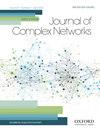Ensemble of opinion dynamics models to understand the role of the undecided about vaccines
IF 1.5
4区 数学
Q2 MATHEMATICS, INTERDISCIPLINARY APPLICATIONS
引用次数: 0
Abstract
In the last years, vaccines debate has attracted the attention of all the social media, with an outstanding increase during COVID-19 vaccination campaigns. The topic has created at least two opposing factions, pro- and anti-vaccines, that have conflicting and incompatible narratives. However, a not negligible fraction of the population has an unclear position, as many citizens feel confused by the vast amount of information coming from both sides in the online social network. The engagement of the undecided population by the two parties has a key role in the success of the vaccination campaigns. In this article, we present three models used to describe the recruitment of the undecided population by pro-vax and no-vax factions in a three-states context. Starting from real-world data of Facebook pages previously labelled as pro-, anti-vaccines or neutral, we describe and compare three opinion dynamics models that catch different behaviours of the undecided population. The first one is a variation of the SIS model, where undecided position is considered an indifferent position, including users not interested in the discussion. Neutrals can be 'infected' by one of the two extreme factions, joining their side, and they 'recover' when they lose interest in the debate and go back to neutrality. The second model studied is a Voters model with three parties: neutral pages represent a centrist position. They lean on their original ideas, that are different from both the other parties. The last is the Bilingual model adapted to the vaccination debate: it describes a context where neutral individuals are in agreement with both pro- and anti-vax factions, with a position of compromise between the extremes ('bilingualism'). If they have a one-sided neighbourhood, the necessity (or the convenience) to agree with both parties comes out, and bi-linguists can become mono-linguists. Our results depicts an agreement between the three models: anti-vax opinion propagates more than pro-vax, thanks to an initial strategic position in the online social network (even if they start with a smaller population). While most of the pro-vaccines nodes are segregated in their own communities, no-vaccines ones are entangled at the core of the network, where the majority of the undecided population is located. In the last section, we propose and compare some policies that could be applied to the network to prevent anti-vax overcome: they lead us to conclude that censoring strategies are not effective, as well as segregating scenarios based on unfollowing decisions, while the addition of links in the network favours the containment of the pro-vax domain, reducing the distance between pro-vaxxers and undecided population.意见动态模型的集合,以了解对疫苗的犹豫不决的作用
在过去几年中,疫苗辩论吸引了所有社交媒体的关注,在COVID-19疫苗接种运动期间,这一辩论显著增加。这个话题至少产生了两个对立的派系,支持和反对疫苗,他们有相互冲突和不相容的叙述。然而,也有不可忽视的一部分人持不明确的立场,因为许多公民对在线社交网络中来自双方的大量信息感到困惑。双方让尚未决定的人口参与进来,对疫苗接种运动的成功发挥了关键作用。在本文中,我们提出了三个模型,用于描述在三州背景下,支持和不支持疫苗的派系对未决定人口的招募。从Facebook页面的真实数据开始,我们描述并比较了三种观点动态模型,这些模型捕捉了未决定人群的不同行为。第一种是SIS模型的变体,其中未决定的位置被认为是一个冷漠的位置,包括对讨论不感兴趣的用户。中立者可能会被两个极端派系中的一个“感染”,加入他们的阵营,当他们对辩论失去兴趣并回到中立时,他们就会“恢复”。研究的第二个模型是具有三方的选民模型:中立页面代表中间派立场。他们依靠自己的原创想法,这些想法与其他两党都不同。最后一种是适用于疫苗接种辩论的双语模型:它描述了一种情况,在这种情况下,中立的个人与支持和反对接种疫苗的派系都持一致意见,在极端之间采取妥协立场(“双语主义”)。如果他们的邻居是一边倒的,那么双方都同意的必要性(或便利性)就会显现出来,双语者就会变成单语者。我们的结果描述了三种模式之间的一致:由于在在线社交网络中的初始战略地位(即使他们从较小的人口开始),反疫苗的观点比支持疫苗的观点传播得更多。虽然大多数支持接种疫苗的节点在自己的社区中被隔离,但未接种疫苗的节点在网络的核心处纠缠在一起,而大多数未决定接种疫苗的人口都位于那里。在最后一节中,我们提出并比较了一些可以应用于网络以防止反疫苗克服的政策:它们使我们得出结论,审查策略无效,以及基于不遵循决策的隔离情景,而在网络中添加链接有利于遏制支持疫苗的领域,减少支持疫苗者与未决定人口之间的距离。
本文章由计算机程序翻译,如有差异,请以英文原文为准。
求助全文
约1分钟内获得全文
求助全文
来源期刊

Journal of complex networks
MATHEMATICS, INTERDISCIPLINARY APPLICATIONS-
CiteScore
4.20
自引率
9.50%
发文量
40
期刊介绍:
Journal of Complex Networks publishes original articles and reviews with a significant contribution to the analysis and understanding of complex networks and its applications in diverse fields. Complex networks are loosely defined as networks with nontrivial topology and dynamics, which appear as the skeletons of complex systems in the real-world. The journal covers everything from the basic mathematical, physical and computational principles needed for studying complex networks to their applications leading to predictive models in molecular, biological, ecological, informational, engineering, social, technological and other systems. It includes, but is not limited to, the following topics: - Mathematical and numerical analysis of networks - Network theory and computer sciences - Structural analysis of networks - Dynamics on networks - Physical models on networks - Networks and epidemiology - Social, socio-economic and political networks - Ecological networks - Technological and infrastructural networks - Brain and tissue networks - Biological and molecular networks - Spatial networks - Techno-social networks i.e. online social networks, social networking sites, social media - Other applications of networks - Evolving networks - Multilayer networks - Game theory on networks - Biomedicine related networks - Animal social networks - Climate networks - Cognitive, language and informational network
 求助内容:
求助内容: 应助结果提醒方式:
应助结果提醒方式:


